Catocala benjamini
kah-TOCK-uh-lahmben-jam-MIN-ee
Brower, 1937
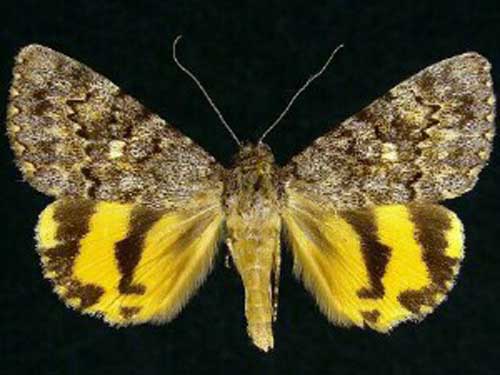
Catocala benjamini, courtesy of John Peackock
at http://mothphotographersgroup.msstate.edu/Files/JP/JP46.1.shtml
This site has been created by
Bill Oehlke.
Comments, suggestions and/or additional information are welcomed by Bill.
| TAXONOMY:
Superfamily: Noctuoidea
Family: Erebidae, Leach, [1815]
Subfamily: Erebinae, Leach, [1815]
Tribe: Catocalini, Boisduval, [1828]
Genus: Catocala, Schrank, 1802
|
DISTRIBUTION:
Catocala benjamini, Benjamin's
Underwing, (wingspan: mm) flies in
Arizona,
Nevada, southern
California and
southern Utah.
Dr. Wayne Whaley reports "It does fly in southwestern Utah. I have several
specimens from Leeds Canyon, north of St. George in June.
Larvae feed on prickly oak."
The nominate subspecies is known from dry mountain ranges in
"southeastern California: San Bernardino;
Arizona: Apache, Cochise, Coconino, Gila, Graham, Mohave, Maricopa, Navajo, Pima, Yavapai;
southern Nevada: Clark, Lincoln;
southwestern Utah: Washington.
"Adults have been collected from May to September with most from June and July. The immature
stages of the nominate subspecies are unknown. However, at several of the known
collecting localities (e.g., Hualapai and Pinal Mountains) Quercus turbinella Greene is
the only species of oak. Additionally, the known distribution of C. b. benjamini closely
coincides with the distribution of Q. turbinella. Like C. frederici, C. b. benjamini primarily
inhabits dry desert mountain ranges." David Hawks.
It is subspecies Catocala benjamini mayhewi
that flies in southern California where it has been recorded in Riverside County, Santa Rosa Mountains,
Pinyon Flat, 1500 m.
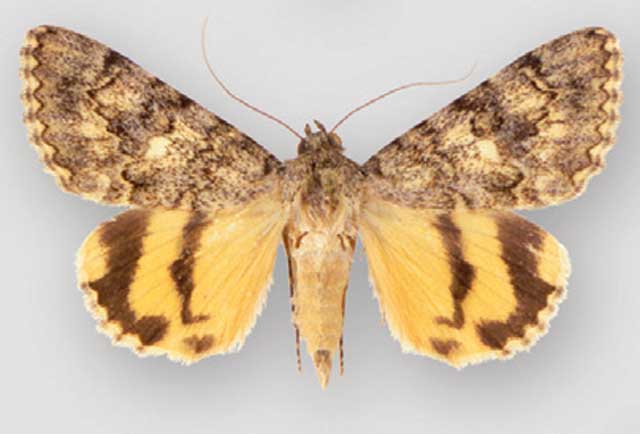
Catocala benjamini mayhewi, Pinyon Flat, Santa Rosa Mountains, Riverside County, California,
Holotype male, 19.5mm, June 22, 1987, 1500m, courtesy of David Hawks.
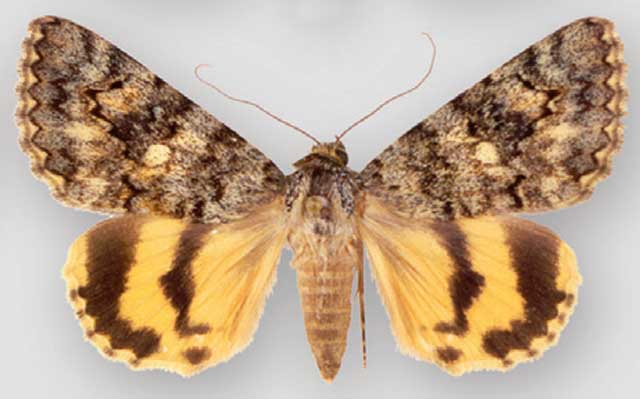
Catocala benjamini mayhewi, Pinyon Flat, Santa Rosa Mountains, Riverside County, California,
Allotype female, 21mm, June 22, 1987, 1500m, courtesy of David Hawks.
Catocala benjamini jumpi flies exclusively in the Kofa Mountains of
Arizona in Yuma County, Kofa Queen Canyon at elevations around 900 m. It is on the wing in May-June.
"Larvae likely feed exclusively on Quercus turbinella since this is the
only oak occurring in the area." David Hawks.
"C. benjamini jumpi differs from other C. benjamini subspecies in having
pale dusky-yellow hindwing bands; forewings distinctly narrower and more pointed;
lines less distinct; ventral surface yellow areas paler; black hindwing bands tend to
be wider; inner band, outer band, and anal spot sometimes fused." David Hawks.
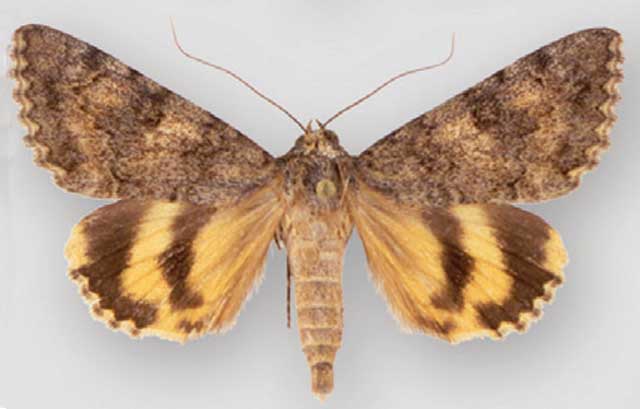
Catocala benjamini jumpi, Kofa Queen Canyon, Kofa Mountains, Yuma County, Arizona,
holotype male, May 1989, 900m, courtesy of David Hawks.
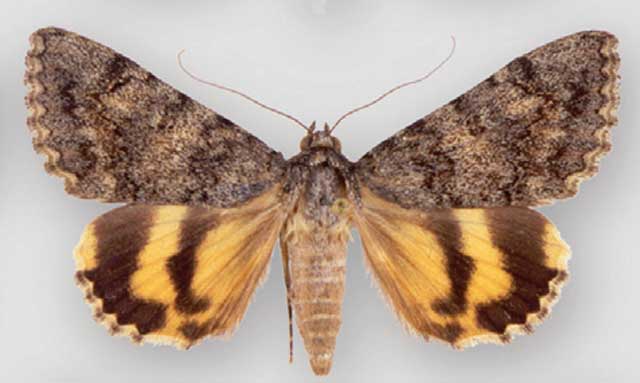
Catocala benjamini jumpi, Kofa Queen Canyon, Kofa Mountains, Yuma County, Arizona,
allotype female, May 1989, 900m, courtesy of David Hawks.
Catocala benjamini ute Peacock & Wagner, 2009, flies in southeastern Utah (Grand and San Juan counties) in the
Balanced Rock Area at elevations around 1610 m. So far it has only been observed in June. It is anticipated that
larvae feed on Quercus × pauciloba Rydb. (= Q. undulata Torr.; a hybrid from Q.
gambelii Nutt. and Q. turbinella).
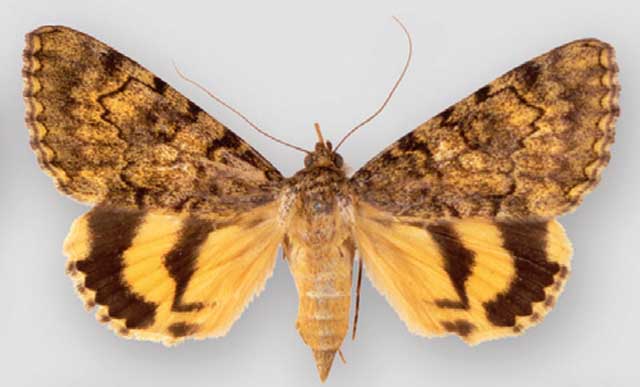
Catocala benjamini ute, courtesy of David Hawks.
The nominate subspecies flies in all four states. It has been recorded in Mohave County, Arizona.
FLIGHT TIMES AND PREFERRED FOOD PLANTS:
Catocala benjamini are usually on the wing in June.
The Catocala benjamini caterpillar probably eats Gambel oak.
ECLOSION:
Adults eclose from pupae at soil surface.
SCENTING AND MATING:
Catocala benjamini females
emit an airbourne pheromone and males use their antennae to track the
scent plume.
EGGS, CATERPILLARS, COCOONS AND PUPAE:
Eggs are deposited on
tree bark in the fall and hatch the following spring.
Larval Food Plants
Listed below are primary food plant(s) and alternate food plants.
It is hoped that this alphabetical listing followed by the common
name of the foodplant will prove useful. The list is not exhaustive,
although some species seem very host specific.
Experimenting with closely related foodplants is worthwhile.
Quercus gambelli.....
|
Gambel oak
|
Return to Main Index
This page is brought to you by Bill Oehlke and the
WLSS. Pages are on space rented from Bizland. If you would like to become a "Patron of the Sphingidae/Catocala Sites", contact Bill.
Please send sightings/images to Bill. I will do my best to respond to requests for identification help.
Enjoy one of nature's wonderments: Live Saturniidae (Giant Silkmoth) cocoons.

|

To show appreciation for this site, click on the flashing
butterfly to the left, a link
to many worldwide insect sites. |
Visit Catocala delilah Species Complex; Author: David Hawks.
Visit California Catocala
immatures







